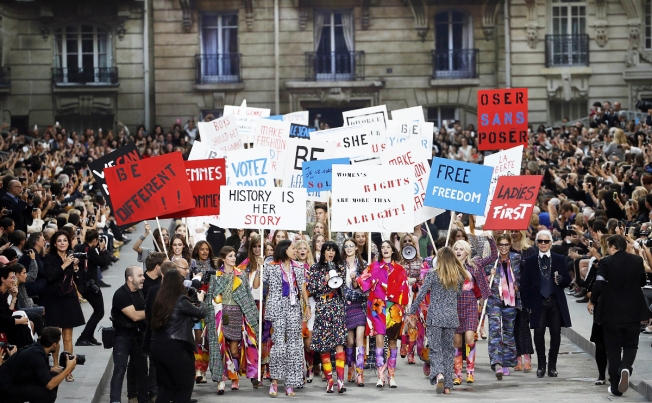
Fashion’s relationship to feminism has always been on an unsteady ground. Some argue that the industry poses a hindrance, which objectifies women and marginalizes people of color. Others say that fashion is empowering and provides a medium, where women and men can defy societal norms and belong to a space where everyone is equal. Though I’m well aware of the fashion industry’s flaws and controversies, I believe in fashion as a mode of freedom and expression.
One of my favorite hobbies is watching runway shows. Haute couture is always an adventure and you never know what you will discover. Whether it’s the clothes, the scenery, the music or the overall theme of the show, the best ones always leave an impression on you.
Recently, I watched the Chanel show at Copenhagen Fashion Week and I was blown away! The entire show was set up like the Grand Palais. There were life-sized silhouettes of buildings mimicking the Parisian streets from Les Miserables. At the end of the show, the models rallied down the catwalk in a small protest, complete with hand-made signs saying “History is Her Story” and “Ladies First.” There was even a male model carrying a sign that read, “He for She,” an echo of Emma Watson’s now-infamous United Nations speech. The women were all smiles and the faux-protest seemed like a jovial affair. It was a lighthearted political statement, but it had weight to it.
Personally, I feel that feminism is getting too serious and we have to make it more accessible to younger men and women. I liked that the models were enjoying themselves, because it reflected the high spirits and optimism of many great feminists.
As for the clothes, many of the models dressed like working women in power suits or stay-at-home mothers in playful and colorful garb. The clothing illustrated the fact that feminism is not merely a working woman’s issue. It applies to every woman. However, I will add that the extravagance and drama of the show made up for the fact that most of the outfits were just ordinary. There were only a few pieces that really made an impression on me apart from the bags and shoes. I felt that the magic of the show laid in the actions of the models and their handbags.
To be honest, I am a sucker for Chanel handbags, especially the ones from this ready-to-wear collection. Some of my favorites includes a plastic pink clutch with the words “feministe mais feminine” (feminist but feminine) emblazoned on the side. Another bag shaped like a speaker was include in many of the outfits, which symbolized the need for moderate feminism to be more vocal in society–at least that’s what I thought. There are so many inaccurate notions of feminists as man-hating, baby-killing ugly women. It’s our job to represent the true image of moderate feminism and I loved how this handbag summed up that idea.
I have always thought of fashion as a friend of feminism. As a young child, I lived in poverty for a couple of years. I could not buy the clothes I wanted because my family did not have the means. When I wore a nice outfit to school or got a new pair of shoes, I would feel powerful. It had such an enlivening effect on my eight-year-old self. From this experience I have come to believe that a strong independent woman can dress however she wants. Whether you feel your best in yoga pants or a $3,000 Chanel suit, wear it with power. If you walk like a model, you are one, regardless of your size, color or shape.
If you missed the show, then watch it out below!




